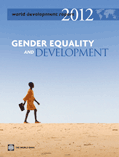Resource Title
World Development Report 2012: Gender Equality and Development
Summary
The World Bank publishes its annual World Development Report (WDR) with a focus a different specific development challenge each year. The WDR 2012, focuses on gender equality, arguing that investing in women is an economically sound strategy that can enhance productivity, improve development outcomes for the next generation, and make institutions more representative. It demonstrates how although women’s lives around the world have significantly improved, gaps remain in many areas: reducing excess female mortality and closing education gaps where they remain, improving access to economic opportunities for women, increasing women’s voice and agency in the household and in society and limiting the reproduction of gender inequality across generations. The report examines the progress to date, and recommends policy actions. Interactive graphs, double page spreads and tables of information are included also.
Resource Details
Description
At 458 pages this is an inescapably long report. It argues that gender is a core development objective in its own right. It is also smart economics – greater gender equality can enhance productivity, improve development outcomes for the next generation, and make institutions more representative.
The Report focuses on four priority areas for policy action: (i) reducing excess female mortality and closing education gaps, (ii) improving access to economic opportunities for women (iii) increasing women’s voice and agency in the household and in society and (iv) limiting the reproduction of gender inequality across generations.
Divided into nine chapters, the report seeks to take practical, measurable stock of where differences between men and women matter, what gains have been made and what are the persistent obstacles to reversing gender inequalities. With a rigorous evidence base used as its core framework to analyse the interaction of households, markets and institutions on women’s agency, the World Bank has made a concerted effort in expanding its policy portfolio by acknowledging the central challenges (and opportunities) that tackling gender inequalities present to ‘development’.
The report concludes by examining the political economy of reforms for gender equality. It proposes a global agenda for action through domestic and international public action and in the form of a detailed checklist of policy interventions through financial support, fostering innovation and learning and leveraging effective partnerships.
The report succeeds in making its findings, conclusions and recommendations accessible to a wider audience of readers than simply policymakers and academics. With supporting interactive web pages to accompany the report – that are continually expanding – it is clear that tackling gender inequality is a central aspect of the World Bank’s development approach.
Interactive graphs, expanded online support and a diverse range of videos available at the WDR 2012 website.
Big Ideas in this Resource
Gender equality matters for development:
- Productivity gains
- Improved outcomes for the next generation
- More representative decision making
Development programming has closed some gaps…
- Educational enrolment
- Life expectancy
- Labour force participation
…but other gaps persist
- excess? deaths of girls and women
- disparities in girls’ schooling
- differences in voice in households in society
In understanding the progress and persistence:
- Income growth by itself does not deliver greater gender equality on all fronts
- Gender gaps persist where girls and women face other disadvantages
- Markets, institutions and households can also combine to limit progress
- Globalization can help
Priorities for domestic policy action are:
- To reduce excess deaths of girls and women
- To shrink persisting educational gaps
- To narrow disparities between women and men in earnings and productivity
- To diminish gender differences in household and societal voice
- To limit the reproduction of gender inequality across generations
Available from:
Purchase a copy of the report on the World Bank website and view individual sections and chapters on the World Bank website here.
Also available on Amazon.

